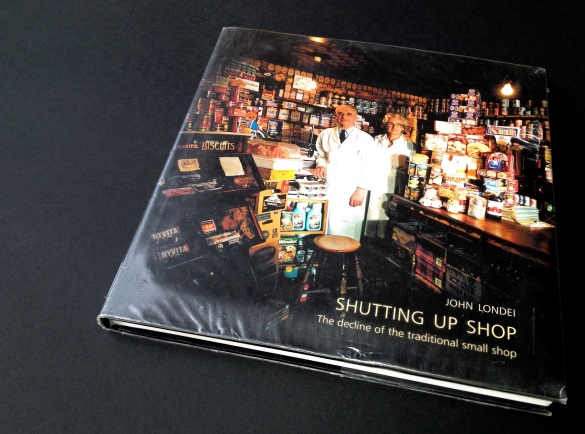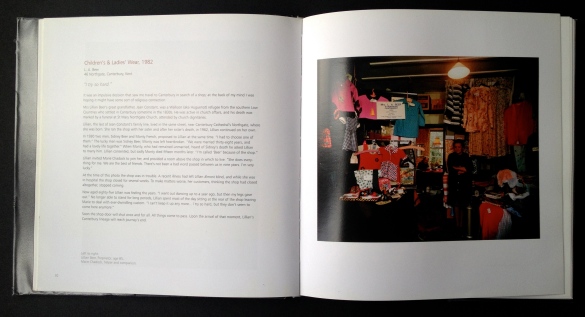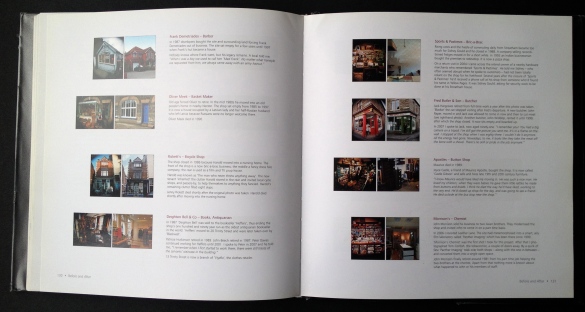Today we had tutorial sessions in small groups in which we each took an image that would inform/inspire/shape our project. I had printed out one of Rob Evans’ images in readiness, but that was before I had discovered John Londei’s book. I’d planned this morning to present the whole book as my inspiration, but at the last minute thought I should show one image so used his image of a cobbler on the grounds that the cobbler in Stevenage is one of the people I’d really hope to be able to use in my project. Before showing the book and the cobbler, I did briefly outline my idea.
The point of the group tutorial was to encourage some discussion and elicit ideas from the group of eight or so classmates and one tutor, and we had a good discussion about the merits or otherwise of my thoughts so far. One classmate took a few notes of the discussion, so here’s the bullet points they noted down, with what I can remember of the discussion:
- Locality – personal connection but limited
I think this simply refers to my outline of the project, that it is my own connection with Stevenage that sets the scope of the project, but inherently limits it, too. - Venture from above, expand project
One classmate thought I was (ironically!) staying in my comfort zone by shooting in Stevenage rather than beyond, and indeed there are many more beautiful in other local towns like Hitchin and St Albans. Of course there are. But in my mind the whole point of this is to document my home town. It’s my own connection with Stevenage that drives this project. If it goes well, I said, maybe I could expand it later. - Possible changes; lighting (do you need to change?)
I can’t really recall what this refers to! Oops. I had mentioned the need to analyse the lighting and approach each location individually as no two shops will be the same. - Have shopkeeper in background
This was following a discussion of whether or not particular shopkeepers will want to get involved. Someone suggested I could perhaps persuade some by having them ‘working in the background’ rather than featured as a portrait. - Complete High Street
Following on from the above, a couple of people thought I should aim to somehow record the ‘whole’ High Street, so if there are shopkeepers who don’t want to be featured, I’d need to have some wide shots showing their shops in relation to the surroundings and so on. - Photograph shops from outside
…which leads neatly to this one. Flicking through John Londei as we chatted, I realised for the first time just how many of his were shot outside the shops, with the staff posing in the doorway. It’s more than the internal shots. I think I overall prefer the internal shots, and certainly that’s what I first envisaged, there is undoubtedly something lovely about the context that the exterior shots give, when you can see the type of building and the signage. Perhaps a mixed appraoch might be useful, and could be dictated by the shop. - Don’t just pick pretty shops!
This was part of a discussion about whether to include the likes of Costa and Tesco, or solely focus on the small independents. I certainly hadn’t planned to make ‘pretty’ one my criteria. - Link yourself to the work
This was related to my own connection to Stevenage, and my approach to potential subjects. I’ll certainly, when explaining the plans to the shopkeepers, want to say that I’m a local photographer who’s known and loved the High Street all my life and want to record it. - Zoe Leonard, Deutsche Börse Photography prize 2010
Our tutor Michael Heilgemeir suggested I should look at the work of Zoe Leonard, who was nominated for the Deutsche Börse Photography Prize in 2010 for her project “analogue” which was based on shopfronts. I’ve had a quick look, and that will have to be the subject of a whole other entry here. - Linking photographic approach with work
This stems from a technical discussion, in particular relating to taking an analogue approach. John Londei’s series were all shot on an 8″ x 10″ plate camera, and he talks about this being reflective of the shops he was photographing being something from a bygone era. Zoe Leonard, photographing 25 years later than Londei, also chose to shoot analogue for similar reasons. Whilst I can see the connection, I’m not planning to go this route. My confidence with lighting and exposures isn’t sufficient (yet?!) to shoot a project like this without the ability to check what I’m doing as I go along, so it will be a digital shoot for me. - Do you incude chains?
I’ve mentioned this above. It’s still a matter needing some thought. My instinct is mixed here. Waitrose has been on the High Street throughout my life and feels like part of the community as a result. Tesco opened a small branch a couple of years ago and still feels like an intrusion. I’d happily include Waitrose, but reluctantly Tesco. This feels wrong, like I’m making a moral decision about what should be in the High Street rather than documenting what is. Of course there is also a practical issue involved in including the chains: I’d imagine it nigh on impossible to get permission to shoot in Tesco, compared with, say, “The Florist on the Green”. And if it’s about people, which in my mind it is, who should be included in the chains? It’s not like they’ve made the shops their own, reflecting their own personality. - Showing change in personal connection between big changes and small businesses
Follows on from previous point. Could I find a way to represent the change from the personal, individual service you get from an independent shopkeeper owning their own shop and knowing their customers, to the ‘disconnected’ service more typical of an employee of a big chain. - Document facts of High Street (types of businesses, numbers, etc.)
I’d briefly mentioned some of my statistics about the numbers of different kinds of shops/businesses, and people thought it a good idea to somehow incorporate some of these into the project.
Well, there you go. Lots to think about. Currently on my list of things to do for this project:
- review Zoe Leonard’s work (and ask for permission to reproduce a few)
- draft a potential letter to introduce project to shopkeepers
- arrange to attend meeting of Old Town Business and Community Association, hope to get their whole-hearted support
- make mood-board for next tutorial.
That should keep me busy.


